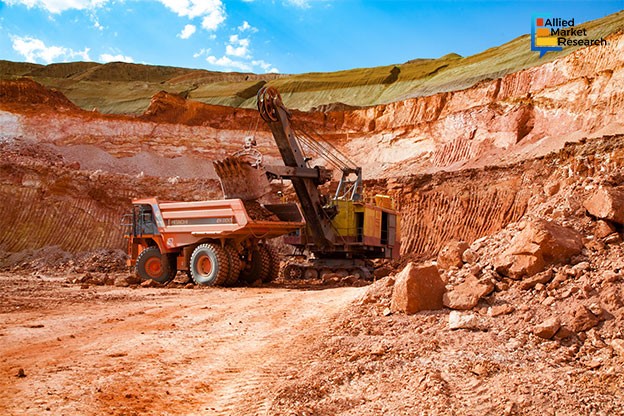Which Modern-Age Bauxite Mining Machines Can Empower Your Mining Activities?

16 Feb
2024
Highlights:
- Introduction
- Popular types of cutting-edge machines used for bauxite mining
- Emphasizing sustainable mining practices by leading operators
- Key acquisitions by prominent players in the domain
Aluminum is the most abundant metal found in the Earth’s crust. The process of extracting aluminum from bauxite is called bauxite mining, commonly known as bauxite mining. Over the years, this process of mining has been remarkably refined by employing sophisticated heavy machinery. Moreover, the latest industrial breakthroughs and the rise of Industry 4.0 automation have led to a better yield from the mines. With the growing demand for aluminum across various sectors, the bauxite mining sector has embraced the latest technologies which has given birth to a wide array of modern machines that can execute such tasks with greater efficiency and precision.
Which modern bauxite mining heavy machines can reshape various ore mining activities?
With technological advancements, several aluminum-producing manufacturers have started adopting machines that can effectively carry out mining operations. Excavators are one of the ground-breaking machines that can be ideal for such activities. These machines can be highly beneficial for removing soil layers and uncovering the valuable bauxite underneath. They help in exploring and scooping up the ore that can be prepared for further processing.
Drilling rigs are one of the modern-age machines that are mainly used to carry out high-powered drills on steroids. They are used to bore deep into the ground and create holes for the explosives. These machines are useful for collecting samples of ores that can help manufacturers for further processing. These drilling rigs can help find the best spots for extracting bauxite. Boart Longyear, Atlas Copco, and Sandvik are some of the leading companies that produce a wide range of drilling rigs.
Next comes the crushers. These are the huge machines that are mainly used to break down large chunks of bauxite into smaller ones. These machines are highly helpful in turning raw bauxite ores into usable ones, making them into the right sizes for further processing. Haul trucks are another category of machines that are broadly used in mining activities. These trucks are mainly for the transport of mined bauxite from the mining site to the processing plants. They can carry tons of bauxite at once and reach the processing plant without missing one. Volvo, Caterpillar, Komatsu, and BelAZ are some leading manufacturers of these haul trucks.
Why are mining industries supporting a stable supply of cost-competitive and low-emission aluminum?
According to a recent report produced by the Climate-Smart Mining department of the World Bank, decarbonization across the aluminum supply chain is highly essential for retaining competitiveness. Aluminum extraction undergoes several processes that can cause carbon emissions to the atmosphere. To combat such issues, many mining operators have started emphasizing the decarbonization of the entire aluminum value chain. These decarbonization processes comprise various steps including using electricity in metal production, methods used to extract ore, and many more. By adopting sustainable practices in aluminum production, many developing countries can compete with the rising carbon-constrained world. Many mining sectors in developing countries are also emphasizing the recycling of aluminum to reduce the carbon footprint of the material by up to 20 times. As aluminum is one of the recycled elements, it can offer near infinite recyclability, providing competitive and low-emission materials for the energy transition.
How are the leading companies unlocking promising opportunities in the domain?
The bauxite mining industry is witnessing prominent growth and is anticipated to rise at a CAGR of 4.1% from 2023 to 2032. Many leading players in the domain have made alliances, mergers, partnerships, and acquisitions to stay ahead in the competitive landscape. For example, Mytilineos Energy & Metals, a global industrial and energy company announced its acquisition of 100% of the shares of Imerys Bauxites, a leading producer of metallurgical-grade bauxite. With this acquisition, Mytilineos aimed to expand its bauxite production capacity by meeting an annual production amount of 570,000 tons of bauxite.
Another instance is the acquisition of Norsk Hydro, a leading aluminum and renewable energy company in Brazil by Glencore, a Swiss multinational commodity trading and mining company. With this acquisition, the companies aimed to adopt sustainable practices for aluminum production by substituting fuel oil with liquified natural gas along with electrification of boilers.
To conclude, the increasing demand for aluminum, especially in the automotive and aerospace sectors will bring extensive opportunities in the domain in the coming era. Furthermore, the growing emphasis on sustainable and responsible mining processes will drive the sector to achieve new peaks in the future.
To gain insights into the bauxite mining market and identify new markets for expansion, feel free to talk to our esteemed analysts today! They can also help your business identify new market segments and growth opportunities.

Rosy Behera
Author's Bio- Rosy Behera holds a bachelor’s degree in Electrical and Electronics Engineering and now she is a content writer by profession. She loves to portray her thoughts and ideas with a nice command of words. Grabbing an audience with her creative write-ups is one of her biggest assets so far. Apart from writing, she is a certified “Odisi” dancer and has done Gardharva in Drawing, Painting, and Arts. She always explores new things through travel and is a big foodie.
Avenue: Entire Library membership of Allied Market Research Reports at your disposal
- Avenue is an innovative subscription-based online report database.
- Avail an online access to the entire library of syndicated reports on more than 2,000 niche industries and company profiles on more than 12,000 firms across 11 domains.
- A cost-effective model tailored for entrepreneurs, investors, and students & researchers at universities.
- Request customizations, suggest new reports, and avail analyst support as per your requirements.
- Get an access to the library of reports at any time from any device and anywhere.
Related Post
-
How are Submarine Cables Transforming Global Connectivity with Enhanced User Experience?
-
Endoscopy Procedures: Transformations in Techniques and Applications
-
AI-Powered Video Analytics: How the Product Actually Works for enterprises
-
Painting Robots: Transforming Precision Coating and Creative Applications
-
Innovations in Pharmacovigilance Systems Advancing Patient Safety
-
Understanding Edge Security: Keeping Data Safe Near the Source
-
Exploring the Use and Advancements of 3D Laser Scanners in Professional Applications
-
Reinforcing Industrial Controls with Smarter Tools and Training








